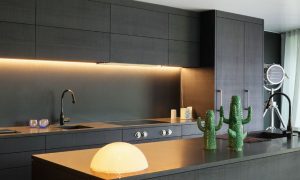It’s pretty funny that the word “peacock” has become synonymous with the color white, but it’s true: British kitchen designer Christopher Peacock is the man responsible for the white kitchen trend that took off like a gas fire in a forest full of dry timber nearly a decade ago. Anyone lucky enough to able to fork over the 100-grand-plus necessary for a genuine Peacock kitchen for your NYC apartment could be sitting pretty in a white cooking palace. Even people with Peacock tastes and pigeon pocketbooks got in on the action, replicating the look and feel of a Peacock kitchen with DIY skills and shrewd appliance and hardware purchases scored at discount stores and Craigslist.
People in search of a little more sass, flash, and dash sought out designers like Clive Christian, a cabinet maker and kitchen designer with a more flashy and opulent signature. What’s next on the horizon? The black kitchen.
Before you recoil in horror, know that the black kitchen train has already left the station, and there are a lot of people on it. Black can bring elegance, drama, subtlety, and beautiful energy to a boring kitchen. Intrigued, but still unconvinced? Check out below for ideas on how to pull it off.
1. Make Sure There’s Plenty of Light
Black attracts light and sucks it in, so a lack of light in a room filled with lots of black elements can quickly turn into a black hole. In order to prevent having to summon Captain Picard and the crew of the Enterprise, you need to make sure that your kitchen gets plenty of light, preferably via windows or skylights.
If you’re sitting in your tiny, windowless kitchen right now shaking your fist at the screen, don’t worry: You can increase the amount of lighting in the room. Use elements like recessed lighting. Overhead lighting set on dimmers can help you control the amount of light that’s in the room at any given time.
2. Choose the Perfect Shade of Black
Contrary to what you may think, there are many different shades of black. Some blacks are deep, smoky greys, while others are brilliantly rich obsidians. Each shade reacts differently in a room, so get samples of the materials you’re interested in and see how they look in the room. Pay attention to sheen: Matte black wooden cabinets will feel very different in a kitchen than glossy black lacquer ones.
3. You Don’t Have to Go All the Way
A kitchen can “read” black, whether it’s a room filled with black appliances and black walls or it’s simply graced with subtle accents. You can get your “black” kitchen without going all the way. Paint your cabinets black or buy new ones. Replace a bland countertop with a high-gloss black stone or laminate. Paint your walls a crisp creamy white, but fill the room with black cabinetry.
4. Bring in Warming Textures
A key commonality among most beautiful black kitchens is the presence of other textures and colors in those kitchens that help balance out the intensity of the black tones. Few things are more stunning than a kitchen filled with black cabinets offset by gorgeous polished wood or white marble counters. Wood or cork floors bring warmth to a room filled with black cabinetry. An island made with a contrasting material can lighten the feel of a room. A gorgeous, colorful Kilim rug can help make a black kitchen feel cozy.
Image Source: Flickr/Steve Larkin
[cf]skyword_tracking_tag[/cf]






